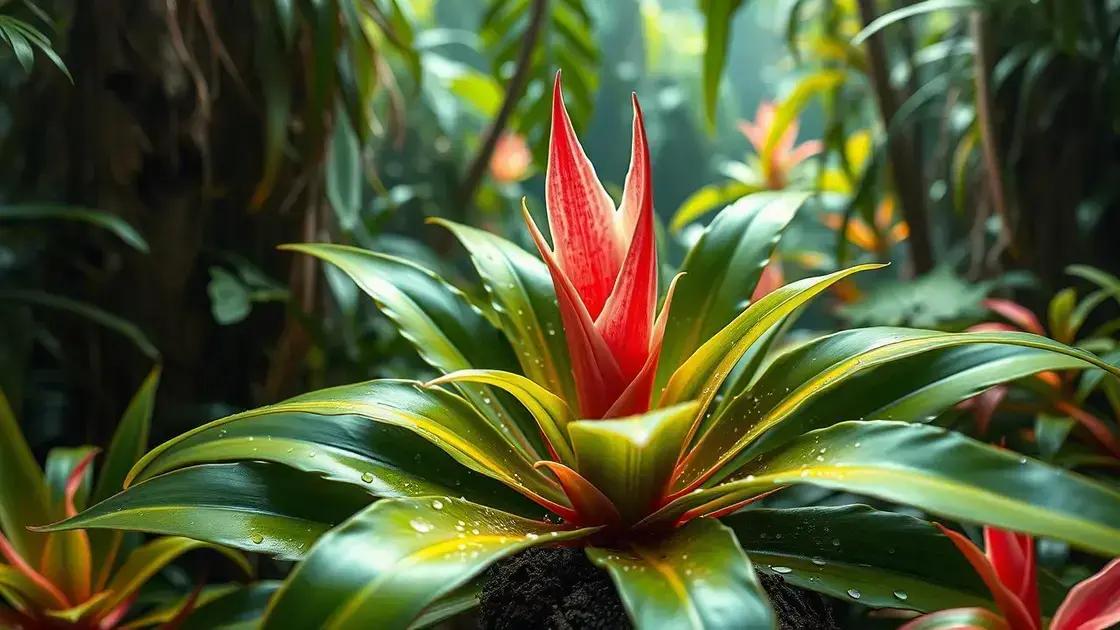How to Care for a Bromeliad Plant: 7 Essential Tips for Success
How to care for a bromeliad plant? If you’ve ever admired their stunning colors and unique shapes, you might wonder how to keep these beauties alive. Understanding their specific needs can guide you to achieve vibrant blooms and healthy foliage. In this post, we’ll explore essential tips for nurturing your bromeliad, ensuring that it complements your indoor garden beautifully.
Table of Contents
ToggleWatering techniques for bromeliads
Watering techniques for bromeliads are essential to their care and overall health. These beautiful plants have unique watering requirements that differ from traditional houseplants. Because they are native to tropical regions, understanding their needs will help you keep them vibrant and thriving.
How often should you water your bromeliad?
It is important to establish a consistent watering routine. Here are some guidelines:
- Water your bromeliad every 1-2 weeks.
- Check the moisture level of the soil before watering.
- Ensure that your bromeliad has adequate humidity levels in the surrounding environment.
Watering methods
Proper watering techniques can significantly impact the health of your bromeliad. Here’s how to do it:
- Fill the central cup of the bromeliad with water.
- Allow rainwater or distilled water to saturate the root zone.
- Drain excess water to avoid root rot.
Common watering mistakes
Avoid these pitfalls when caring for your bromeliad plant:
- Overwatering can lead to root rot, so always check moisture levels.
- Using tap water can introduce chemicals that harm the plant.
- Neglecting the bromeliad’s specific humidity needs can lead to stress.
For more tips, consider exploring indoor gardening techniques.
Real-life example
Hello, my name is Jenna, and I’ve successfully nurtured several bromeliads over the years. Initially, I struggled with watering routines, often overwatering. Once I adopted a consistent watering schedule and focused on the central cup method, my plants flourished!
Meta description: Learn effective watering techniques for bromeliads to keep your plant healthy and vibrant. Discover tips on frequency, methods, and common mistakes.
Optimal light requirements for bromeliad plants

Optimal light requirements for bromeliad plants are crucial for their growth and blooming. These unique plants thrive under specific lighting conditions that mimic their natural habitat in the tropical forests. Knowing how to provide the right amount of light is essential for keeping your bromeliad healthy and beautiful.
Understanding light levels
Bromeliads can be sensitive to light. Here are the key light levels they prefer:
- Bright indirect light is ideal for most bromeliads.
- Some varieties can tolerate moderate indirect light.
- Avoid direct sunlight, which can scorch their leaves.
Signs of improper lighting
Recognizing the signs that your bromeliad is not receiving proper light can help you make adjustments:
- Yellowing leaves indicate too much direct sunlight.
- Stretching or leggy growth suggests insufficient light.
- Slow or no growth can signify inadequate light conditions.
Best placement for light
Consider the following placements to optimize light exposure for your bromeliad:
- Place them near a window with filtered light.
- Use sheer curtains to diffuse harsh sunlight.
- Rotate the plant occasionally for even light exposure.
For further insights, you might enjoy exploring indoor gardening techniques to enhance your bromeliad’s environment.
Real-world experience
My experience with bromeliads taught me the importance of light placement. I initially kept my plants in bright direct sun, which damaged their leaves. After adjusting their location to indirect light, they thrived, showcasing vibrant colors and healthy growth.
Meta description: Discover the optimal light requirements for bromeliad plants to promote healthy growth and vibrant blooms while enhancing your indoor garden.
Fertilizing bromeliads for healthy growth
Fertilizing bromeliads for healthy growth is a key aspect of their care. While bromeliads can survive with little fertilization, providing the right nutrients supports robust growth and vibrant blooms. Understanding how to fertilize these plants allows you to enhance their natural beauty.
Choosing the right fertilizer
Selecting an appropriate fertilizer is crucial. Consider these types that work well for bromeliads:
- Water-soluble fertilizers with a balanced NPK ratio.
- Slow-release fertilizers are beneficial during the growing season.
- Organic options, like fish emulsion, provide nutrients without harsh chemicals.
How often to fertilize your bromeliad
The timing and frequency of fertilization can make a significant impact:
- Fertilize during the growing season, approximately every 4-6 weeks.
- Reduce frequency in the fall and winter when growth slows.
- Dilute the fertilizer to half the recommended strength to prevent burning the roots.
Signs of nutrient deficiency
It’s essential to recognize the signs that your bromeliad may need fertilization:
- Pale or yellowing leaves can indicate a lack of essential nutrients.
- Slow growth or lack of blooms may suggest insufficient fertilization.
- Weak, leggy growth can highlight the need for more nutrients.
For additional insights, you can benefit from exploring indoor gardening techniques to give your bromeliads the care they need.
My experience with bromeliad fertilization
Personal experience has taught me the importance of fertilizing bromeliads. Initially, I neglected this step and saw little growth. Once I started a consistent fertilization routine, my plants began to flourish, producing stunning blooms.
Meta description: Learn effective fertilizing techniques for bromeliads to ensure healthy growth and beautiful blooms while enhancing your indoor gardening skills.
In conclusion
Caring for bromeliads requires attention to their unique needs, from proper watering techniques and light requirements to effective fertilization strategies. By understanding these essential aspects, you can ensure that your bromeliads thrive and showcase their beauty. Remember, nurturing these stunning plants is a rewarding journey that enhances your indoor space. For more insights and tips on enhancing your indoor garden, continue exploring your gardening passion.

